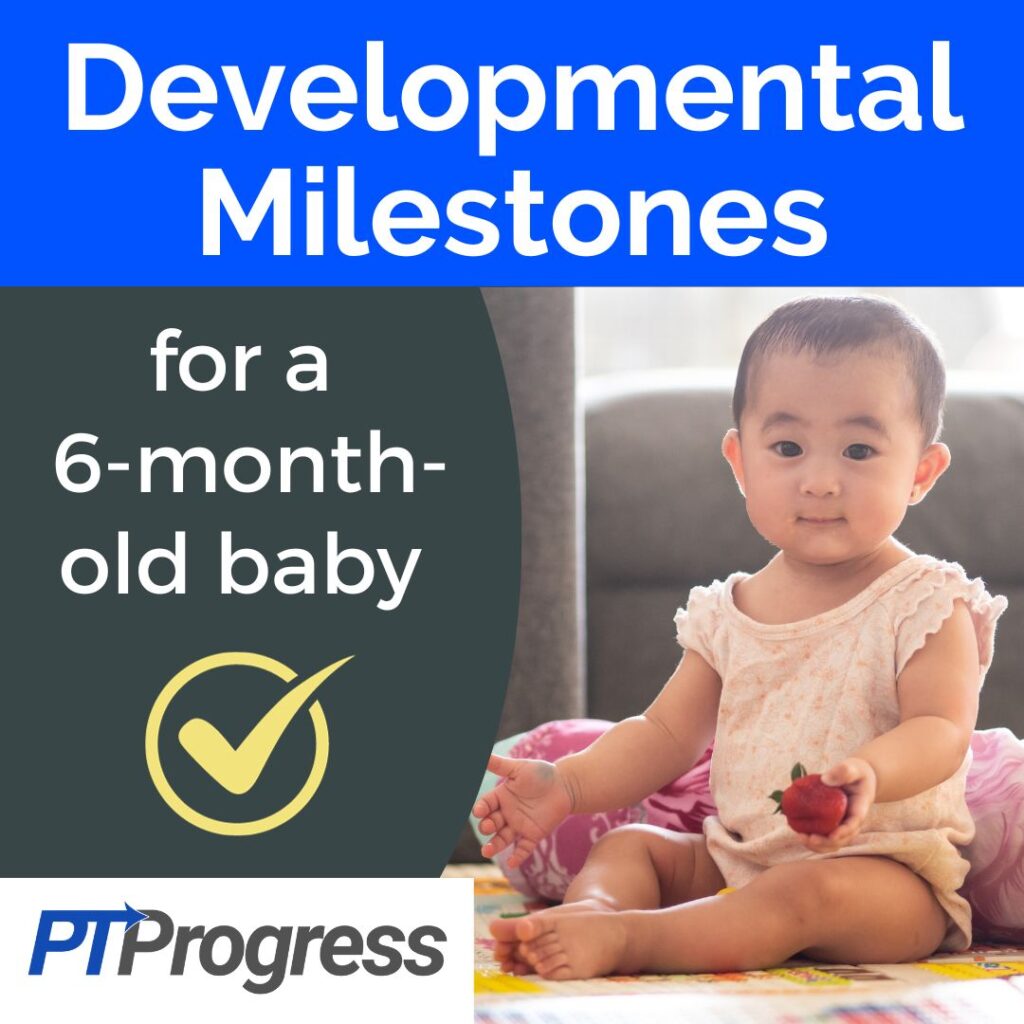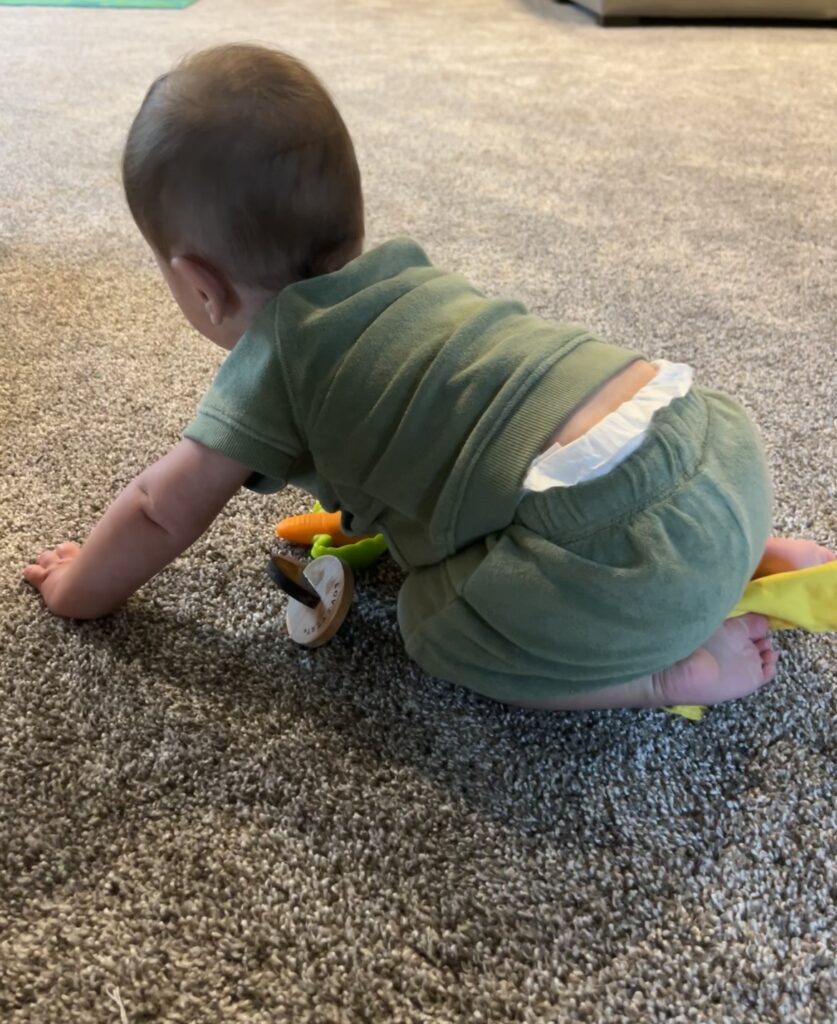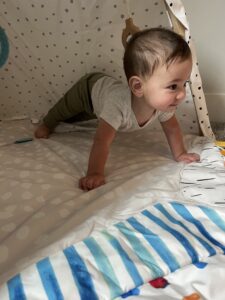
As your baby grows and changes, you’ll see rapid developments in their reflexes, mobility, motor control, and strength. Each month I share the insights of a pediatric occupational therapist on what to expect in your baby’s growth. Keep reading for the latest report, documenting the developmental milestones of a 6-month-old. We’ll cover main reflexes to observe, other milestones and their implications for development, as well as answers to some common questions you may have.
Introduction
Your 6-month-old is gaining more and more skills by the day! As your baby prepares to start crawling, they may exhibit a new primitive reflex, the Symmetric Tonic Neck Reflex (STNR). Your baby may start sitting independently and begin to notice every sight and sound around them! Another sign your baby is 6 months old is that it has become increasingly more difficult to hold your baby, now that they can reach with their entire body for what they want. All told, there are many exciting milestones to watch for this month!
Reflexes
The main emerging reflex to watch out for in your 6-month-old is the STNR:

Jack demonstrating the Symmetric Tonic Neck Reflex
Symmetric Tonic Neck Reflex (STNR)
The Symmetric Tonic Neck Reflex typically develops between 6–9 months of age and should integrate around 12 months. The STNR affects the relationship between your baby’s head position and their arm and leg positions. For example, when your baby’s chin lowers or moves towards their chest, the reflex will cause their legs to straighten and their arms to bend. It works the opposite way, too: when their head tilts backward or away from their chest, their legs should bend and their arms straighten. As you can see in the picture, Jack’s head is tilted backwards, his legs are bent, and his arms are straight.
Why is it important?
Also known as the crawling reflex, the STNR plays an important role in helping your baby start to crawl. With this reflex, your baby can quickly learn to assume a crawling position as well as move their upper and lower extremities independently of each other.
What happens if it doesn’t integrate by 12 months?
Like many reflexes, the STNR should integrate (or no longer be a reflex) by the time your baby is 12 months old. However, if it hasn’t integrated by then, it may not be a concern if any of the following apply to your baby: they skipped crawling on their hands and knees and went straight to walking; they crawl on their hands and feet (also called bear walking); or they get around by scooting on their bottom.
Remember, you’re not the only one keeping track of your baby’s milestones and reflexes; your pediatrician will also be aware of their development. Feel free to mention any concerns you may have at your next appointment, including about the Symmetrical Tonic Neck reflex.
And if you’re still seeing the STNR in your child as they near school age, your pediatrician can refer you to an occupational therapist, who will use integration techniques and exercises to help your child finish this step in their development.
Other reflexes:
Your 6-month-old may still show the following reflexes, some which can integrate by this age:
- Palmar Grasp Reflex
- Asymmetrical Tonic Neck Reflex (ATNR)
- Spinal Galant
- Spinal Perez
You can read about each of these reflexes in more detail in the 5-Month-Old Developmental Milestones Report.
If the above reflexes haven’t integrated yet, don’t worry. Every child is different, and yours may follow a schedule other than what’s outlined as “normal” in these reports. Any concerns you may have about your baby’s development are best brought to the attention of their pediatrician.
Developmental Milestones of 6-month-old
Mobility

Jack is getting ready to crawl
At 6 months, your baby is on a roll! Quite literally, they may be doing lots of rolling. If they didn’t already begin ambulating at 5 months, by now they should be using their hands to move their body around. If they spot something they like, they will definitely try to go get it!
You may also see your baby start to change positions on their own, such as sitting from a lying down position or vice versa. Maybe your baby can even get into a crawling position and rock back and forth on their hands and knees. They might even be able to assume a plank position, like Jack in the photo below—impressive, right?

Actual crawling may not begin for a couple more months, but rest assured, your baby is gearing up to be on the move! So if you haven’t already, consider baby-proofing your house (think: outlet covers, corner guards, safety gates, and cabinet locks). Once they start moving, everything is fair game!
Motor Control / Strength
Jack can sit on his own!
There are many strength and motor control milestones to watch for in your 6-month-old. Have you noticed them sitting independently, without any support from you or other objects? Their balance may still be a little shaky, so continue to monitor them closely to catch them if they fall backwards or take a nosedive.
As your baby builds muscle strength, you will feel them put weight into their legs when you hold them in a standing position. Pushing up onto their hands when lying on their tummy is another strong stepping stone that will help them become more mobile soon.
You have probably noticed it’s increasingly more difficult to hold your baby because they reach for everything in sight. However, now that your baby is stronger, the muscles in their torso can hold themselves upright in your arms, making it easier for you to simply sit them on your hip.
Jack’s “raking grasp”
Keep monitoring your baby’s reaching skills as they develop. You should see them using both hands more and more often. When picking up food or other objects, they may use a “raking grasp,” or all of their fingers at once except the thumb.
To help them continue to gain control over their movements and increase strength, play with your baby in a variety of positions: on their back, tummy, or side or in a seated position (supported or unsupported, based on their development). Each position will help strengthen different muscles. For age-appropriate play ideas in each position, check out the 6-month Activity and Exercise Guide!
Cognition
Along with their physical skills, your baby’s cognitive and social-emotional skills are changing by the day! Not only are they more aware of what is happening around them, they are now starting to react. For example, your baby may look around when they hear sounds in their environment to find the source. They’ll also be keen to explore their environment—using their hands and mouths—so be mindful of what objects you have lying around!
Your baby may also start exploring what noises they can make with their mouth. You’ll hear them click their tongue on the roof of their mouth, squeak loudly, smack their lips, or blow raspberries. While it’s super cute to watch them learn these fun noises, accept that spit will go literally everywhere when they blow raspberries.
At this point, continue to introduce a variety of sensory stimuli to your baby, such as different textures, sights, sounds, smells, and tastes! Don’t forget to watch for signs of overstimulation, such as wanting to be held more than usual, or the opposite—withdrawing from your touch and looking away, crying louder with frantic arm/leg movements, or sucking on their fists or fingers. These signs may indicate there is too much happening in their environment and they are feeling stressed.
I share some tips on what to do if your baby appears overstimulated in the 5-month Developmental Milestones Report. For ideas of how to safely introduce different sensory stimuli, check out the 6-month Activity and Exercise Guide!
Separation Anxiety in a 6-Month-Old
As your baby learns to recognize people, distinguishing friends from strangers, they may develop separation anxiety. Telltale signs of separation anxiety include the following: crying when you leave them, waking up crying throughout the night, becoming clingier around new people, or having difficulty falling asleep without a parent or caregiver nearby.
If this describes your child’s behavior, don’t worry—separation anxiety is a completely normal phase for a 6-month-old baby!
What should I do if my baby is starting to have separation anxiety?
Although it’s normal and common, separation anxiety can be very difficult to navigate for parents or caregivers. You hate to hear your baby cry, but you also need to be able to leave for errands or sleep through the night. You have to take care of yourself!
Here are some strategies to help your baby (and you) get through this tricky time:
- After you put your baby in their crib and leave the room, wait to see if they are still crying after 10–15 minutes. If not, great! If they are still crying, go back in the room and talk or sing to them so they know you’re there. Try leaving them again, give it some more time, and if they are still crying, go and comfort them again. If they become totally inconsolable, give them love and cuddles and try this process over again another night.
- Play peek-a-boo or hide-and-seek throughout the day to help them learn that even when you disappear, you always come back!
- Try to stick to a bedtime routine (I know, easier said than done…). A good routine may include giving them a relaxing bath, reading or singing to them, cuddles, etc. Before too long, they will learn to expect and accept bedtime as part of this nightly routine.
- Consider dressing your baby in a weighted sleep sack for bedtime or nap time. Like a weighted blanket, a weighted sleep sack provides light, comforting pressure that can help your baby relax. Check out Dreamland Baby for these wonder-workers! You’ll find on their website lots of great information on safety precautions, proper fit and wear, age considerations, and more!
- If you haven’t tried sleep training yet, there are several methods you can use to help your baby fall asleep independently. You may have heard of some of these methods: the “Cry It Out” or Extinction method, the Ferber method, the Chair method or Sleep Lady Shuffle, Bedtime Fading method, Pick Up/Put Down method, etc.
For more in-depth tips for sleep training your 6-month-old, check out Taking Cara Babies. This online resource offers a great collection of classes that can help you teach your little one to sleep better.

